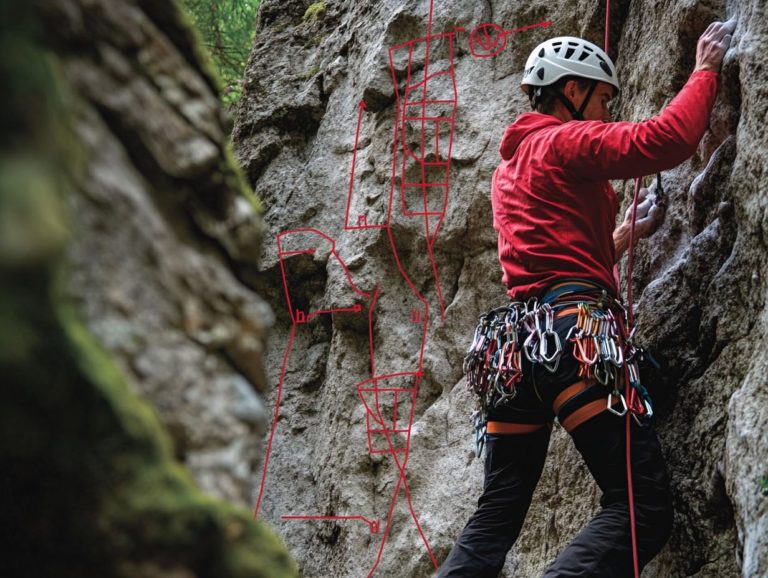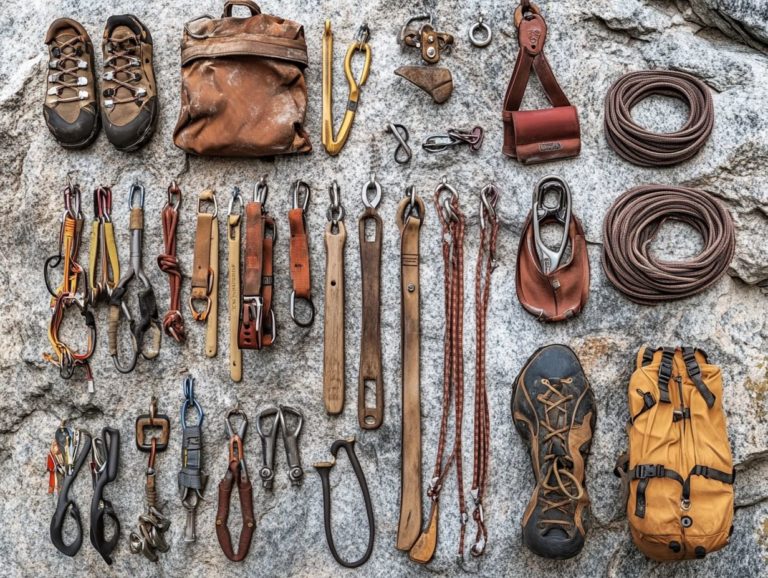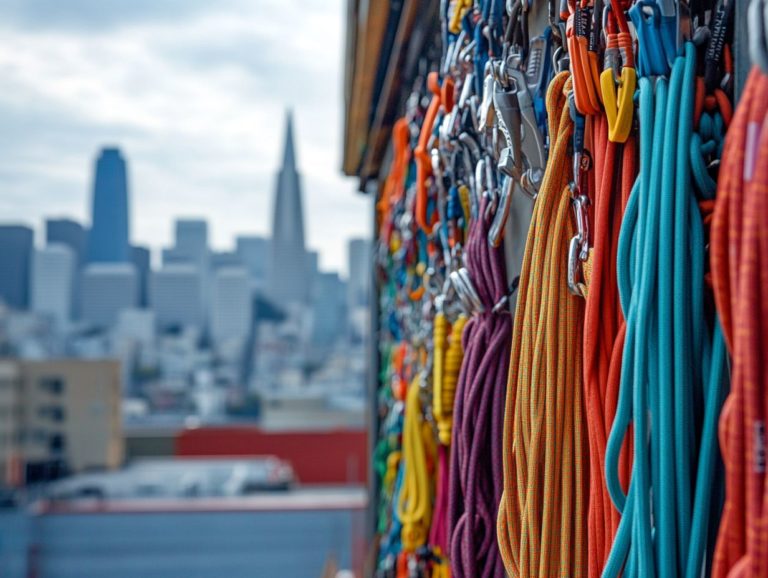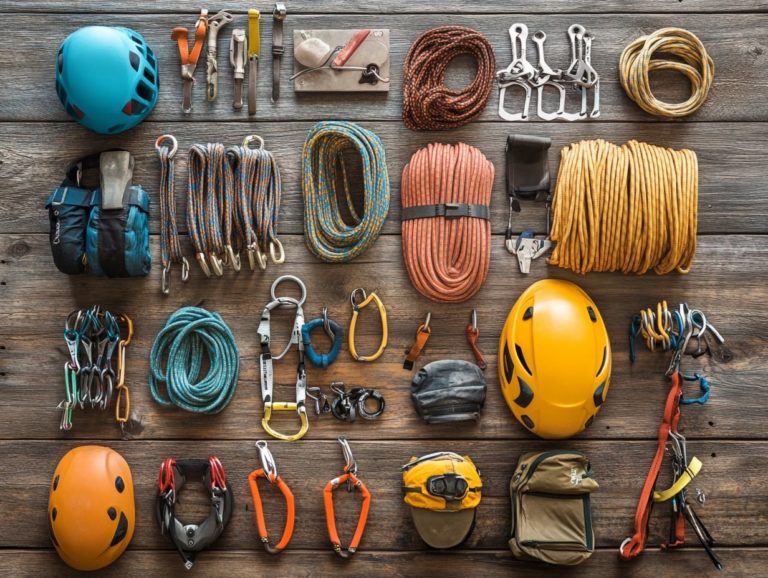Understanding Climbing Gear Ratings Explained
When it comes to climbing, having the right gear is crucial for safety and performance.
With a wide array of equipment at your disposal, understanding gear ratings can truly elevate your experience. This article delves into everything you need to grasp about climbing gear ratings, from deciphering the meaning behind UIAA and CE standards to appreciating the importance of breaking strength and impact force.
You ll explore durability factors and discover tips for selecting the gear that best fits your climbing adventures. Get ready to boost your climbing adventures with informed choices!
Contents
- Key Takeaways:
- Overview of Climbing Gear Ratings
- Types of Gear Ratings
- Understanding Strength Ratings
- Interpreting Impact Force Ratings
- Deciphering Gear Durability Ratings
- Comparing Gear Ratings Across Brands
- Tips for Choosing the Right Rated Gear
- Frequently Asked Questions
- What are climbing gear ratings and why are they important to understand?
- What are the different types of ratings used for climbing gear?
- How are climbing gear ratings determined?
- What is the UIAA and how does it relate to climbing gear ratings?
- Can climbing gear ratings change over time?
- What should I do if I am unsure about a climbing gear rating?
Key Takeaways:
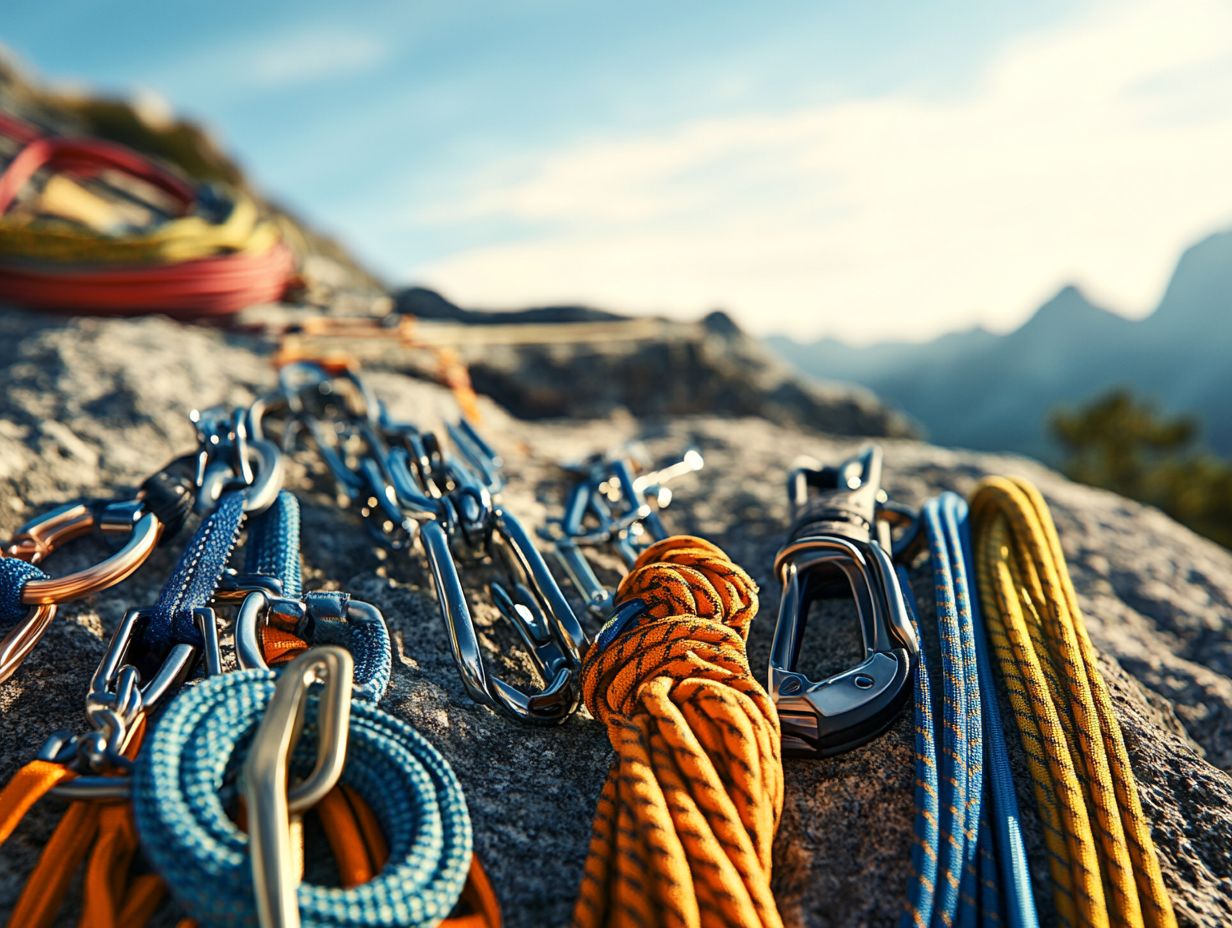
- Climbing gear ratings are crucial for safety and success.
- UIAA, CE, and EN ratings are the most commonly used and reliable ratings for climbing gear.
- When purchasing gear, consider factors such as breaking strength, impact force, and durability to ensure the right rated gear is chosen for the climb.
Overview of Climbing Gear Ratings
Understanding climbing gear ratings is important for you, whether you’re just starting out or have years of experience under your belt.
These ratings offer crucial metrics that ensure your safety while climbing and give you the power to help you make informed choices when selecting your equipment. For more insights, it’s important to understand what to know about climbing gear weights. Gear ratings cover various aspects, including kN ratings, which reflect the strength of your climbing gear and indicate how much force it can withstand.
A solid grasp of these ratings is important as they directly relate to key gear types like climbing ropes, belay devices, and protective equipment, all engineered to endure the significant forces you might face while climbing. For more details, check out our guide on understanding climbing gear weight limits.
What are Gear Ratings?
Gear ratings are the specific metrics assigned to climbing equipment that indicate its ability to withstand the various forces encountered during climbs, including the impact forces generated by falls.
These ratings come from strict testing to ensure your climbing gear can handle tough outdoor conditions. For example, the force experienced during a fall can vary greatly depending on factors such as the climber’s weight, the dynamic nature of the belay, and the type of climbing being undertaken. To better equip yourself, it’s important to understand the different types of climbing gear. A dynamic belay is a technique that helps distribute the force of a fall, making it safer for the climber.
The ability to absorb force is crucial; it not only protects your gear from damage but also enhances overall safety by minimizing the peak loads that can lead to catastrophic failures. Understanding these ratings is essential for climbers, as it ensures you choose the right equipment for your adventures.
Types of Gear Ratings
Climbing gear falls into distinct categories based on their ratings, with the most esteemed being the UIAA, CE, and EN ratings.
Each of these ratings outlines specific safety and performance standards that your climbing equipment must meet to ensure your adventures are not only exhilarating but also secure.
UIAA, CE, and EN Ratings
UIAA, CE, and EN ratings are vital benchmarks for your climbing gear, providing you with a clear understanding of the safety standards and performance expectations of your equipment.
These ratings come from strict testing to ensure your climbing gear can handle tough outdoor conditions. The Union Internationale des Associations d’Alpinisme (UIAA) rating focuses on the durability and reliability of gear, serving as the gold standard for ropes and harnesses. To get a better understanding of pricing, check out this guide on understanding the costs of climbing gear.
The CE (Conformit Europ enne) marking indicates that your gear meets European health, safety, and environmental protection standards. Meanwhile, EN (European Norm) ratings further outline performance criteria for essential components like carabiners and belay devices.
For example, a UIAA-rated rope is built to handle significant impact forces, and you can easily verify compliance by checking for these ratings marked directly on the product tags or in the accompanying documentation.
By understanding these ratings, you give yourself the power to make informed decisions, ultimately enhancing your safety and performance in the vertical world.
Make sure to check your climbing gear ratings before your next adventure!
Understanding Strength Ratings
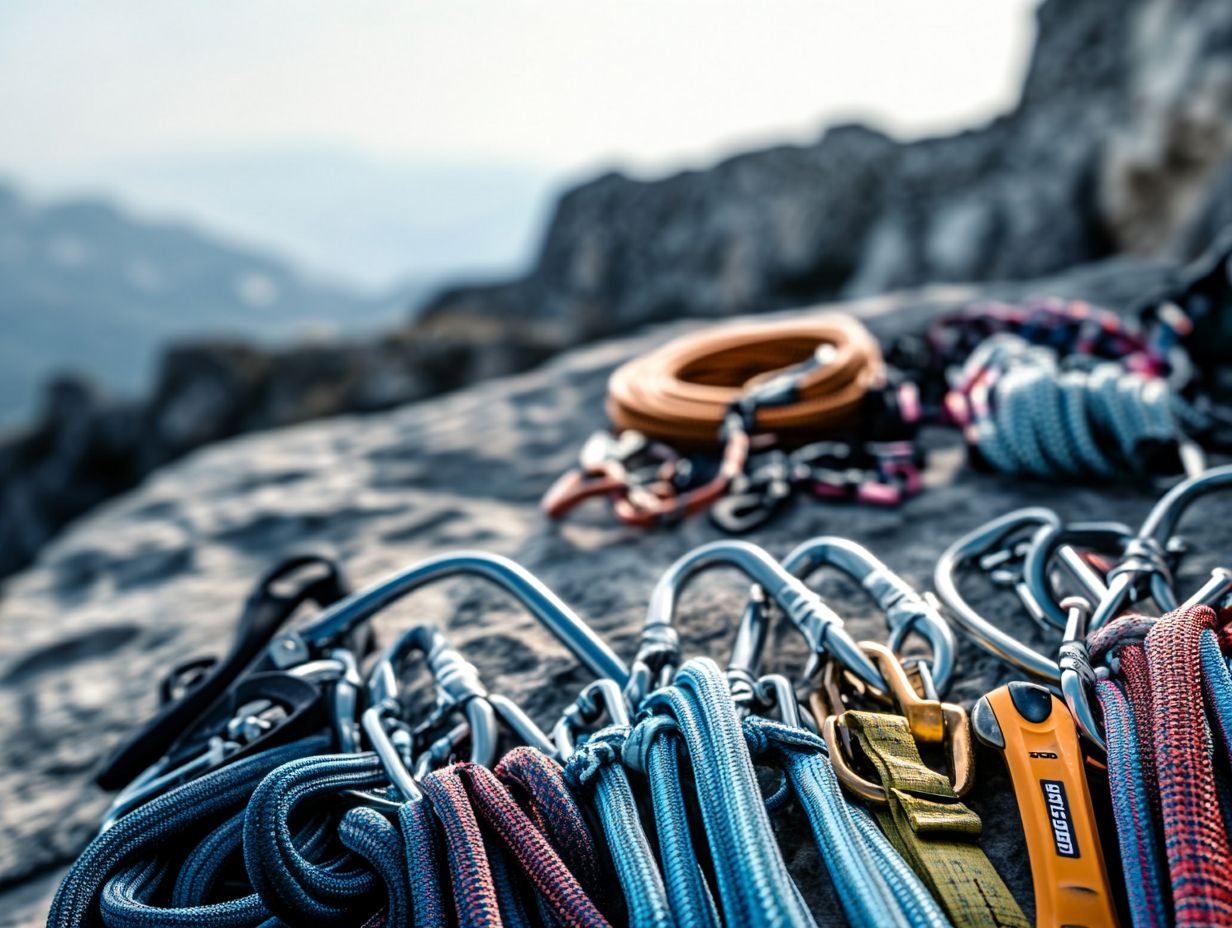
Strength ratings are the cornerstone of climbing safety. They incorporate breaking strength and working load limits. These ratings provide essential insights into the maximum forces that climbing ropes and gear can endure before failure occurs.
Understanding these limits is crucial for your safety as you navigate the challenges of climbing.
Breaking Strength and Working Load Limits
Breaking strength is the maximum force that a piece of climbing gear can endure before it breaks. Working load limits show the safe limits for regular use.
Understanding these definitions is essential for climbers. The breaking strength indicates gear durability limits, so always choose equipment that exceeds the forces you might encounter.
Working load limits help you assess how much weight you can safely apply in typical climbing situations. As you determine your gear requirements, consider your body weight, the likelihood of falls, and the specific climbing environment.
This way, you can calculate which equipment will best support your ascent while prioritizing your safety.
Interpreting Impact Force Ratings
Impact force ratings play a crucial role in assessing the force exerted on climbing gear during falls. Your understanding of these ratings is influenced by various factors, including the fall factor and the type of gear employed.
By understanding these elements, you enhance safety in your climbing endeavors. This knowledge ensures both confidence and security on your adventures.
How Impact Force Affects Climbing
The impact force experienced during a climbing fall can significantly affect both you and your belayer. This underscores the importance of understanding how this force is applied and managed.
When you fall, the sudden deceleration creates a jolt that can heighten the risk of injury. This has potentially serious consequences for both you and your belayer.
Your belayer plays a vital role in this scenario by managing the rope to absorb some of that impact. Techniques like ‘dynamic belaying’ can be quite effective, allowing the rope to stretch slightly and reducing the strain on your body.
Choosing the right anchors and using proper fall techniques can further help mitigate those impact forces. Maintaining a relaxed body posture during a fall is essential.
By prioritizing communication and practicing these techniques, you can create a safer environment and enhance your overall climbing experience.
Deciphering Gear Durability Ratings
Gear durability ratings are essential for grasping the longevity and reliability of climbing equipment. These ratings encompass factors that determine how effectively your gear can endure wear and tear over time.
Understanding them empowers you to make informed choices. This ensures that your adventures are not only thrilling but also safe and dependable.
Factors that Affect Durability
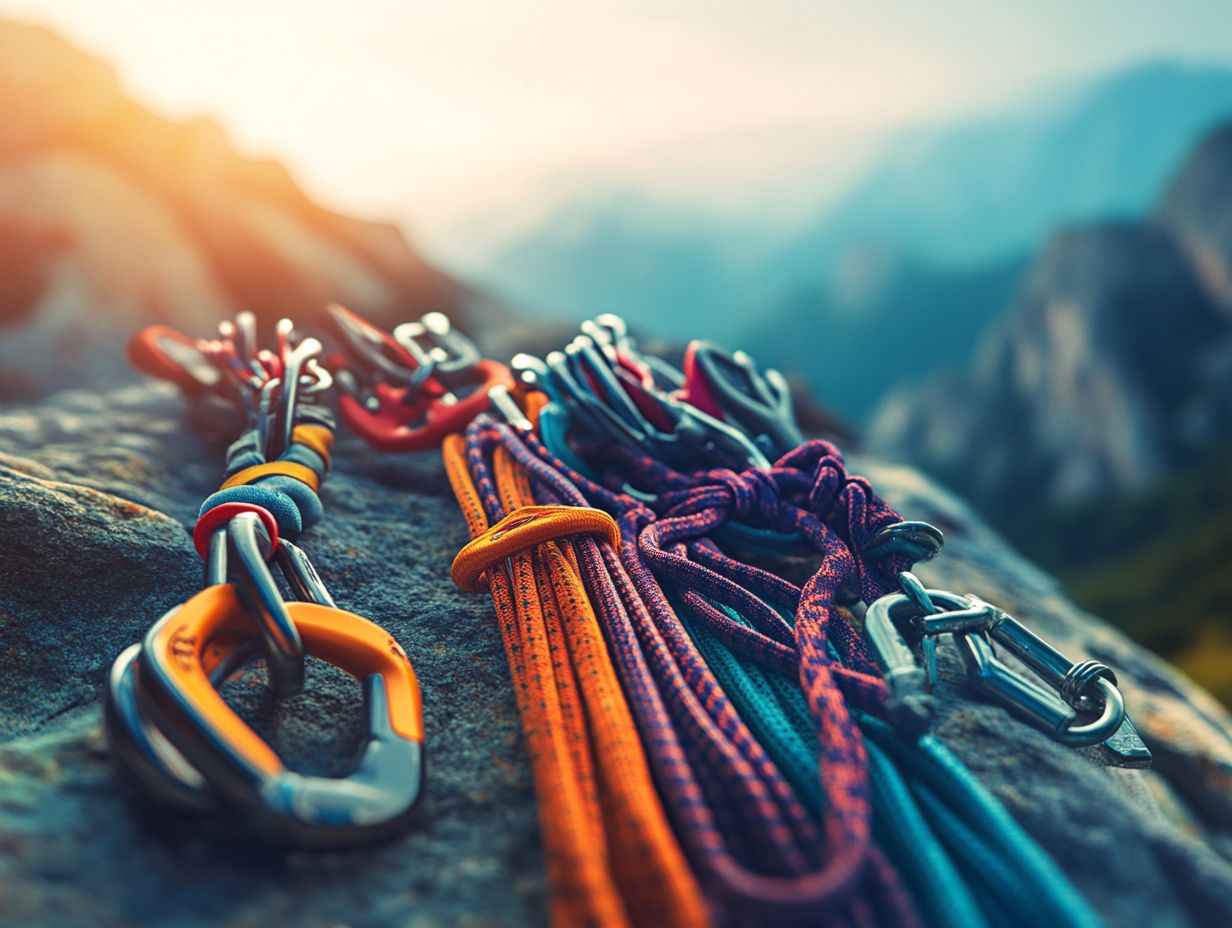
Several factors significantly impact the durability of your climbing gear. These include exposure to environmental conditions, frequency of use, and the level of maintenance you provide.
It’s crucial to understand that elements like UV exposure, moisture, and temperature fluctuations can gradually weaken the materials of your equipment. Frequent use, especially in challenging conditions, can also lead to wear and tear.
To ensure your gear lasts, make it a habit to regularly inspect it for any signs of damage. Implementing proper cleaning and storage practices can greatly enhance its lifespan.
Allow your gear to air dry after each use and keep it in a cool, dry place. By following these steps, you can prioritize your safety and maximize the efficiency of your essential tools during your adventures.
Comparing Gear Ratings Across Brands
When selecting climbing equipment, it’s crucial to compare gear ratings across various brands. The differences in ratings can significantly impact your choice of equipment and ultimately, your safety while scaling those heights.
Consistency and Variations in Ratings
While many brands follow established standards for gear ratings, you may find variations that make it essential for you to recognize and understand these differences.
These differences can arise from several factors, including manufacturing processes, testing methods, and even the brand’s philosophy regarding safety. For you as a climber, this means that the same rated gear from different brands could deliver varying levels of reliability and performance during those critical moments. To make informed choices, it’s essential to understand survival gear ratings.
Take, for example, brands like Black Diamond and Petzl. They re renowned for their exceptional consistency in gear ratings. They rigorously test their products to ensure they meet or even exceed industry standards. Therefore, it’s crucial for you to pay attention to these variations and consider brand reputation when selecting equipment for your adventures, as the stakes can be incredibly high in outdoor environments.
Tips for Choosing the Right Rated Gear
Selecting the right-rated gear can profoundly impact your climbing safety. You must thoughtfully evaluate the various factors that influence your gear choices.
Factors to Consider When Purchasing Gear
- Weight: Consider how your weight influences gear performance. If you re on the heavier side, you may need more robust equipment to withstand the stress during your climbs.
- Intended Use: The specific type of climbing you plan to do whether it’s sport, trad, or alpine will dictate the tools you require, each tailored to the unique challenges of the environment.
- Placement: Understanding proper gear placement is equally crucial. You need to know how and where to position your gear to effectively distribute weight and maximize protection against falls.
By taking these considerations into account, you not only enhance your climbing experience but also significantly reduce the risk of accidents, allowing you to tackle your routes with unwavering confidence.
Frequently Asked Questions
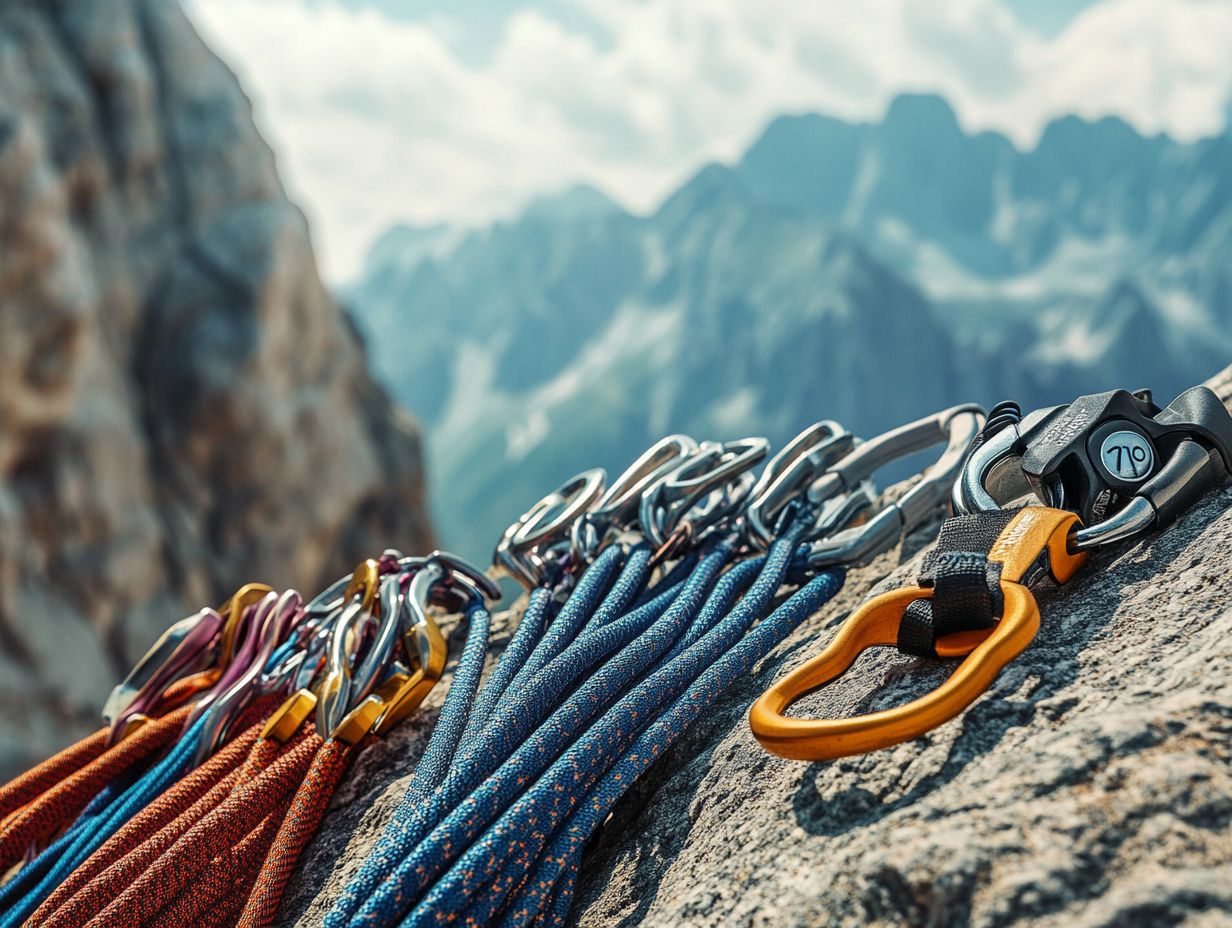
What are climbing gear ratings and why are they important to understand?
Climbing gear ratings are standardized systems used to evaluate the performance, durability, and safety of climbing equipment. Understanding these ratings is crucial for making informed decisions about which gear is appropriate for your climbing needs and ensuring your safety while climbing.
What are the different types of ratings used for climbing gear?
There are several types of ratings used for climbing gear, including strength ratings, impact force ratings, and durability ratings. Each type provides specific information about the performance and safety of the gear.
How are climbing gear ratings determined?
Climbing gear ratings are determined through extensive testing and evaluation by accredited organizations. These organizations follow strict standards and protocols to ensure the accuracy and consistency of the ratings.
What is the UIAA and how does it relate to climbing gear ratings?
The UIAA (International Climbing and Mountaineering Federation) is an international organization that sets standards and guidelines for climbing gear ratings. Many manufacturers use UIAA standards when testing and rating their gear.
Can climbing gear ratings change over time?
Yes, climbing gear ratings can change over time as technology and testing methods improve. You must always check for the most up-to-date ratings when purchasing new gear.
What should I do if I am unsure about a climbing gear rating?
If you are unsure about a climbing gear rating, it’s best to consult with a knowledgeable and experienced climber or professional at a climbing gear store. They can provide you with more information and help you make an informed decision.
Explore more about gear safety or visit a climbing gear resource to enhance your knowledge!

